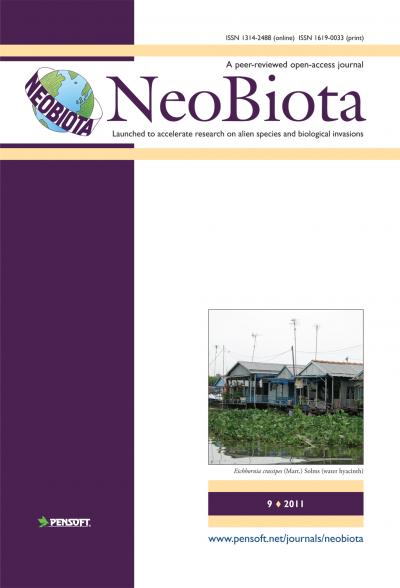Mining生物多样性数据库建立了世界性昆虫mOTUs的全球基线:以膜翅目腹总科(platygastro总科)为例,并对生物防治计划产生影响
IF 3
2区 环境科学与生态学
Q1 BIODIVERSITY CONSERVATION
引用次数: 0
摘要
在过去的十年中,在北美和欧洲发现了几种腹腹小蜂的外来物种,并对其作为入侵害虫的生物防治剂进行检疫评价。这种现象的范围和相对风险尚不完全清楚,但它显然是一种趋势,对传统的生物控制具有影响。作为评估问题和提供全球基线的一种手段,我们对生命条形码数据库中的DNA序列实施了数据挖掘方法,得到了201个具有洲际和岛屿分布的platygastoid bin。至少55个bin显示准确的COI条形码匹配跨大陆,与更多的bin得分为不确定由于序列长度的变化。这些洲际和岛屿垃圾箱包括已知的外来生物防治剂,以及许多仅确定为属的物种,其地理起源不确定。我们提供了2500个platygastrooid BOLD bin的鉴定,88%为属,以鼓励对这种分布现象的进一步研究。将洲际BOLD bin与文献记录和世界性物种的GBIF发生率进行比较,以确定数据源之间的差距和不一致。来自佛罗里达州和德国地区的较小的COI条形码数据集,包括拓扑样本,揭示了更多的洲际匹配。为了更广泛地评估这一现象,我们分析了整个昆虫科和蜘蛛科的COI序列,因为这些分类群包含许多扁胃胡蜂的宿主。该方法揭示了洲际分布现象的广泛存在,对生物多样性评估、分类学方法和监管框架具有重要意义。本文章由计算机程序翻译,如有差异,请以英文原文为准。
Mining biodiversity databases establishes a global baseline of cosmopolitan Insecta mOTUs: a case study on Platygastroidea (Hymenoptera) with consequences for biological control programs
In the past decade, several species of platygastroid wasps were found to be adventive in North America and Europe while under evaluation in quarantine as biological control agents of invasive pests. The scope and relative risk of this phenomenon is not fully known, but it is clearly a trend with implications for classical biological control. As a means of assessing the issue and to provide a global baseline, we implemented a data-mining approach with DNA sequences in the Barcode of Life Database, yielding 201 platygastroid BINs with intercontinental and island distributions. At least fifty-five BINs displayed exact COI barcode matches across continents, with many more BINs scored as inconclusive due to sequence length variation. These intercontinental and island BINs include biocontrol agents known to be adventive, as well as many species identified only to genus with uncertain geographic origins. We provide 2,500 identifications for platygastroid BOLD BINs, 88% to genus, to encourage additional research on this distributional phenomenon. The intercontinental BOLD BINs were compared to literature records and GBIF occurrences of cosmopolitan species to identify gaps and discordance across data sources. Smaller COI barcode datasets from localities in Florida and Germany, including topotypical specimens, revealed more intercontinental matches. We analyzed COI sequences in BOLD for the entirety of Insecta and Araneae to assess this phenomenon more broadly and because these taxa contain many hosts for platygastroid wasps. This method revealed that the intercontinental distribution phenomenon is widespread with implications for assessing biological diversity, taxonomic methodology and regulatory frameworks.
求助全文
通过发布文献求助,成功后即可免费获取论文全文。
去求助
来源期刊

Neobiota
Agricultural and Biological Sciences-Ecology, Evolution, Behavior and Systematics
CiteScore
8.10
自引率
7.80%
发文量
0
审稿时长
6 weeks
期刊介绍:
NeoBiota is a peer-reviewed, open-access, rapid online journal launched to accelerate research on alien species and biological invasions: aquatic and terrestrial, animals, plants, fungi and micro-organisms.
The journal NeoBiota is a continuation of the former NEOBIOTA publication series; for volumes 1-8 see http://www.oekosys.tu-berlin.de/menue/neobiota
All articles are published immediately upon editorial approval. All published papers can be freely copied, downloaded, printed and distributed at no charge for the reader. Authors are thus encouraged to post the pdf files of published papers on their homepages or elsewhere to expedite distribution. There is no charge for color.
 求助内容:
求助内容: 应助结果提醒方式:
应助结果提醒方式:


